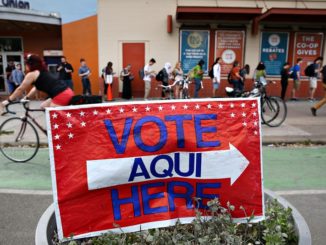
by Elaine C. Kamarck
President Trump’s less than enthusiastic reception in El Paso, Texas, along with the announcements by four Texas Republican congressmen that they will not be running for re-election, has drawn attention to the changing demography of that state. Back in the 19th century a French sociologist first said “Demography is destiny.” And so it is, albeit over the long run. Demographic change is slow, even glacial. But at some point demography becomes destiny.
Could we be on the verge in Texas?
For some time now, Texas has been a proud Republican stronghold, amongst the reddest of the red states. It hasn’t voted for a Democrat for president since it went for Jimmy Carter in 1976. Even the presence of a popular four-term senator from Texas (Lloyd Bentsen) on the Democratic ticket in 1988 did not help. The Democratic candidate for president, Michael Dukakis, lost by nearly eight points and won only 111 electoral college votes. Since then Democrats have pretty much written Texas off. No Democrat has won a statewide office there since 1994. Since 2002, Republicans have controlled the governorship and both houses in the state legislature.
But a funny thing happened in 2018. A young congressman named Beto O’Rourke challenged incumbent Senator Ted Cruz and came within striking distance of winning. He instantly became a national figure (and instantly decided he should be president.) But perhaps we should come back to demography. O’Rourke’s success probably had as much to do with demography as with with his own talents. While O’Rourke was running a close but losing race against Cruz, Democrats were picking up congressional seats in the Dallas suburbs (where Pete Sessions lost his seat) and in the Houston suburbs (where John Culberson lost his seat.) And they were picking up state legislative seats and closing the margins between themselves and the Republican winners statewide.
No wonder four House Republican incumbents from Texas have already announced they won’t run in 2020. Will Hurd (23rd district), the only black Republican in the House, announced he won’t run again after squeaking back into office in 2018 with a 0.5 percent margin. Kenny Marchant (24th district), won with only 3 percent of the vote in 2018 compared to his 17 percent margin in 2016, and Pete Olson (22nd district) won with only 5 percent of the vote in 2018 compared to 19 percent in 2016. The fourth retirement, Mike Conaway (11th district), is the only one retiring whose district doesn’t show signs of a Democratic resurgence (he won by a huge margin); but Conaway, a fixture in the House, has decided that life in the minority is not much fun.
So what’s happening in Texas? Are we finally seeing the maturation of the nation’s largest minority group? The 2018 Texas electorate contained more Latino voters than ever before. And as I have noted previously in Democracy Journal, “According to CNN exit polls, Latinos were 17 percent of the Texas vote in 2014, 24 percent of the state’s vote in 2016, and 26 percent in 2016. In addition, in Texas, as elsewhere in the nation, younger voters were heavily Democratic. Fully 39 percent of the voters in the Texas exit poll were under the age of 44, and 61 percent of Texas voters 45 and older. O’Rourke won the younger voters, and Cruz won the older voters.”
These trends are likely to continue. It’s probably safe to say that nothing President Trump has done as president has increased his popularity among Latino voters. In fact, it is most likely the opposite, as his chilly reception in El Paso illustrated.
And the Latino population in Texas has grown from 25.5 percent in 1990 to 39.6 percent in 2018.[i] Many of these people are citizens and voters. The Census estimated that the median age of Latinos[ii] in Texas in 2018 was 28.9 years old and the median age of the non-Latino population was 38.9 years old. The one thing we know about voting behavior is that people do tend to vote more as they age. So, the large number of young Latinos means that their turnout will, almost surely, increase as they get older.
If, in the next decade, Texas tips from red to purple to blue, Donald Trump will become known as the Pete Wilson of Texas. Wilson was a two-term governor of California who supported a 1994 ballot proposition, Prop 187, that would prohibit illegal immigrants from receiving any social services. The initiative passed but was ruled unconstitutional and never went into effect. And as my colleague Vanessa Williamson has noted, the lasting legacy of Pete Wilson’s Prop 187 was to mobilize Latino voters and push them into the arms of the Democrats. With one exception, California hasn’t had a Republican governor since and the state is solidly blue. Hard to imagine today but California used to be a Republican stronghold in presidential elections. The last Republican to carry the state was George HW Bush in 1988.
In 2020, Republican Senator John Cornyn (Texas) is up for re-election. Two strong potential candidates, Beto O’Rourke and Julian Castro, have (thus far) decided to pass up the race in favor of quixotic races for the presidency. That’s too bad for the Democrats, as 2020 could be the year when demography becomes destiny.
[i] Source: U.S. Census.
[ii] Counting the total Hispanic and non-Hispanic populations irrespective of race.
Elaine C. Kamarck is a Senior Fellow in the Governance Studies program as well as the Director of the Center for Effective Public Management at the Brookings Institution.



